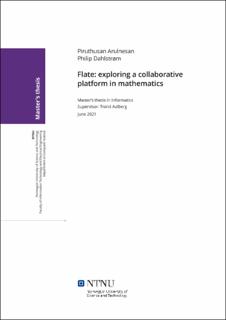| dc.contributor.advisor | Aalberg, Trond | |
| dc.contributor.author | Arulnesan, Piruthusan | |
| dc.contributor.author | Dahlstrøm, Philip | |
| dc.date.accessioned | 2021-12-07T18:19:32Z | |
| dc.date.available | 2021-12-07T18:19:32Z | |
| dc.date.issued | 2021 | |
| dc.identifier | no.ntnu:inspera:74730471:26564443 | |
| dc.identifier.uri | https://hdl.handle.net/11250/2833233 | |
| dc.description.abstract | Flere og flere skoler i Norge velger å tilby elever en personlig digital enhet, som ofte er nettbrett. Den økende bruken av nettbrett i utdanning gir mulighet for å tilpasse konsepter fra gruppevare, f.eks. fra delte tekstredigeringsverktøy, til andre kontekster som samarbeid innen matematikk. Denne oppgaven hadde som mål å tilrettelegge for samarbeid i en programvareplattform med en delt flate hvor elever kan løse matematiske oppgaver sammen.
Hovedbidraget fra dette arbeidet er en fullt fungerende prototype som er lagd for å støtte samarbeid i matematikk. Prototypen ble utviklet ved å først identifisere vanlig funksjonalitet og teknologi innen gruppevare, og så vurdere hva slags funksjonalitet som var nødvendig for å tilrettelegge for samarbeid innen matematikk.
En evaluering av plattformen ble gjort for å identifisere samarbeidsmønstre som dukket opp under bruk av elever i en test-setting. Testen ble gjennomført av tre par med elever. Observasjoner og intervjuer ble gjort for å generere datamateriale. Observasjonene ble gjort med et egenutviklet monitoreringssystem som visualiserte interaksjoner i plattformen. I tillegg ble det tatt feltnotater av samtalen mellom elevene. Semistrukturerte intervjuer med elevene, og læreren deres, ble brukt for å frembringe meninger om samarbeidet. Datamaterialet fra observasjonene ble kvalitativt analysert for å identifisere samarbeidsmønstre, og datamaterialet fra intervjuene ble brukt for å forbedre forståelsen av hvordan elevene jobbet sammen.
Resultatene fra testen viser at elevene samarbeidet på flere måter, og hovedmønstrene ble kategorisert som: parallel, ping-pong, og singular action. I det første samarbeidsmønsteret interagerte elevene parallelt; i det andre var deres interaksjoner alternerende; i det tredje var det bare én elev som interagerte med den delte flaten. I tillegg til disse resultatene, ble det funnet at samarbeidsplattformer ofte fokuserer på transparens, som kan bety at alle brukere blir gjort bevisste og oppdaterte om tilstanden til den delte flaten. Funksjoner som samtidighet når man tegner linjer, å tillate brukere å interagere med objekter, og å oppdatere brukere om hverandres handlinger ble identifisert som de viktigste funksjonene for samarbeid innen matematikk. | |
| dc.description.abstract | More and more schools in Norway are opting to provide pupils with personal digital devices, such as computer tablets. The increased use of tablets in education provides opportunities to adapt concepts from groupware in learning, like shared text editors, to other contexts like collaboration in mathematics. This project aims to explore how to facilitate collaboration in a software platform using a shared workspace.
The main contribution of this work is a fully functioning prototype supporting collaboration in mathematics. It was developed by identifying common features and technologies in groupware and determining which of these features were necessary to facilitate collaboration in mathematics.
An evaluation of the platform was performed to identify collaborative patterns that occurred when pupils used the prototype in a test setting. A test on three pairs of pupils was executed to generate data, with observations and interviews. Observations were performed by using a monitoring system built for the testing and taking field notes of the conversation between the pupils. The system was developed to visualize interactions in the platform as user actions in a scatter plot. Semi-structured interviews with the pupils and the teacher overseeing the test on-site were used to elicit opinions regarding the collaboration. The data from the observations were qualitatively analyzed to identify collaborative patterns, and the data from the interviews were used to enhance the understanding of how the pupils worked together.
Results from the test show that the pupils collaborated in multiple ways, and the main patterns exhibited were categorized as parallel, ping-pong, and singular action. In the first collaboration pattern, the pupils interacted in parallel; in the second, their interactions were alternating; and in the third, only one pupil interacted with the shared workspace. In addition to these results, this thesis found that collaborative platforms often focus on transparency; all users are kept aware and updated regarding the state of the shared workspace. It also identified simultaneity when drawing lines, allowing users to interact with objects, and making users aware of each other's actions as the most significant features to facilitate collaboration in mathematics. | |
| dc.language | eng | |
| dc.publisher | NTNU | |
| dc.title | Flate: exploring a collaborative platform in mathematics | |
| dc.type | Master thesis | |
